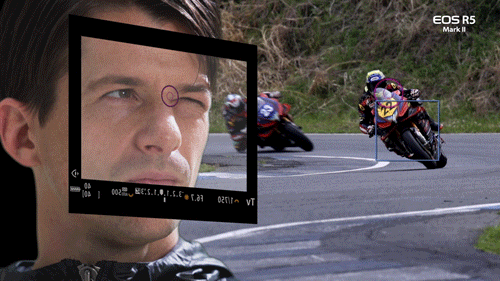
Canon's two new professional cameras, the Canon EOS R1 and Canon EOS R5 Mark II, possess an incredible technology that enables you to move your focus point simply by moving your eyeball.
Yes, when you look around the viewfinder, the cameras will follow your gaze and place your focus point on whatever you're looking at. This amazing tech is called Eye Control AF, and I know it sounds like a gimmick but it really isn't.
Lots of photographers swear by back button focus, and just can't imagine going back to the crudeness of half-pressing the shutter button. Well, once you've started using Eye Control AF, it's the same thing – it's really hard to go back to a camera that doesn't have it! Take a look at this video to get an idea of how it works:
This tech isn't new to the R1 and R5 Mark II; it actually debuted on the Canon EOS R3 (though it's significantly improved in the newer cameras). Going back even further, the original version of this wizardry debuted in 1992 on the Canon EOS A2E (known as the EOS 5 in some territories) when it was called Eye Controlled Focus.
It's based on measuring corneal reflection, but back then the system was pretty hit or miss – particularly if you wore glasses. With just one infrared LED to create measurements, many users found that it wasn't good enough to select an autofocus point – even though the camera only had five total AF points. Today, though, the system harnesses Canon's bleeding-edge technology to make it work almost seamlessly.
The modern electronic viewfinder is outfitted with eight infrared LEDs (including dedicated units for monitoring eyeglasses), all emitting light at different directions and frequencies. The reflected light is measured by an eye-focus sensor that creates a retinal scan, mapped to the image in the finder, and high-speed computation calculates where your eye is looking.

Of course, with every human eye and face being unique, the system is entirely reliant on calibration – in fact, multiple calibrations are required, including recalibration when there's a change in scene (such as going from indoors to outdoors) as this completely changes the light being measured.
Calibration doesn't take long; it's just a matter of looking at dots in different positions in the viewfinder so that the system can start tracking your eye. And this is why not everyone gets great results, as some people only calibrate the system once (if at all) and expect it to work immediately. But come on – you can't do one test at the optician and expect your glasses to work properly!
In case you can't tell, I'm a big fan of the technology – and have been, ever since using it in the R3. It's a different way of working, for sure, and we photographers can be pretty stuck in our ways and dismissive of crazy new things. But trust me, do yourself a favor and give it a try if you have the chance – you might just fall in love with it like I did.
You might be interested in more of the best professional cameras, and particularly the best cameras for sports photography – along with some of the best lenses for sports photography.







